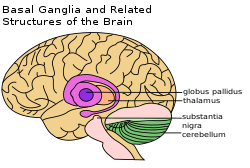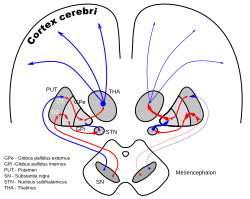Pallidum
| Globus pallidus | |
|---|---|

Globus pallidus labeled at bottom right.
|
|

DA-loops in PD
|
|
| Details | |
| Identifiers | |
| Latin | Globus pallidus |
| MeSH | A08.186.211.730.885.105.487.397 |
| NeuroNames | hier-213 |
| NeuroLex ID | Globus pallidus |
| TA | value%20Entity%20TA98%20EN.htm no value |
| FMA | 61835 |
|
Anatomical terms of neuroanatomy
[]
|
|
The globus pallidus (Latin for "pale globe") also known as paleostriatum or dorsal pallidum, is a sub-cortical structure of the brain. It is part of the telencephalon, but retains close functional ties with the subthalamus - both of which are part of the extrapyramidal motor system. The globus pallidus is a major component of the basal ganglia core along with the striatum and its direct target, the substantia nigra. The latter are made up of similar neuronal elements, have similar afferents from the dorsal striatum, and have a similar synaptology; neither receives cortical afferents.
Pallidal nuclei are made up of the same neuronal components. In primates, almost all pallidal neurons are very large, parvalbumin-positive, with very large dendritic arborizations. These have the peculiarity of having the three-dimensional shape of flat discs, parallel to one another, parallel to the border of the pallidum and perpendicular to the afferent striatopallidal axons. There are only a few small local circuitry neurons.
The globus pallidus is traversed by the numerous myelinated axons of the striato-pallidonigral bundle that give it the pale appearance from which it is named.
The ultrastructure is very peculiar, as the long dendrites are everywhere, without discontinuity, covered by synapses.
In primates, the dorsal pallidum, or globus pallidus, is divided into two parts by the medial medullary lamina. These are often termed "internal" and "external" (the internal globus pallidus [GPi] and the external globus pallidus [GPe]); both are composed of closed nuclei surrounded by myelinic walls.
...
Wikipedia
